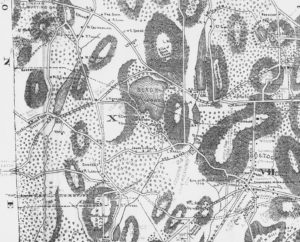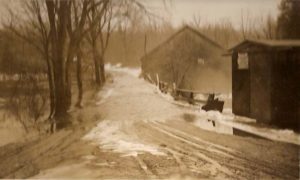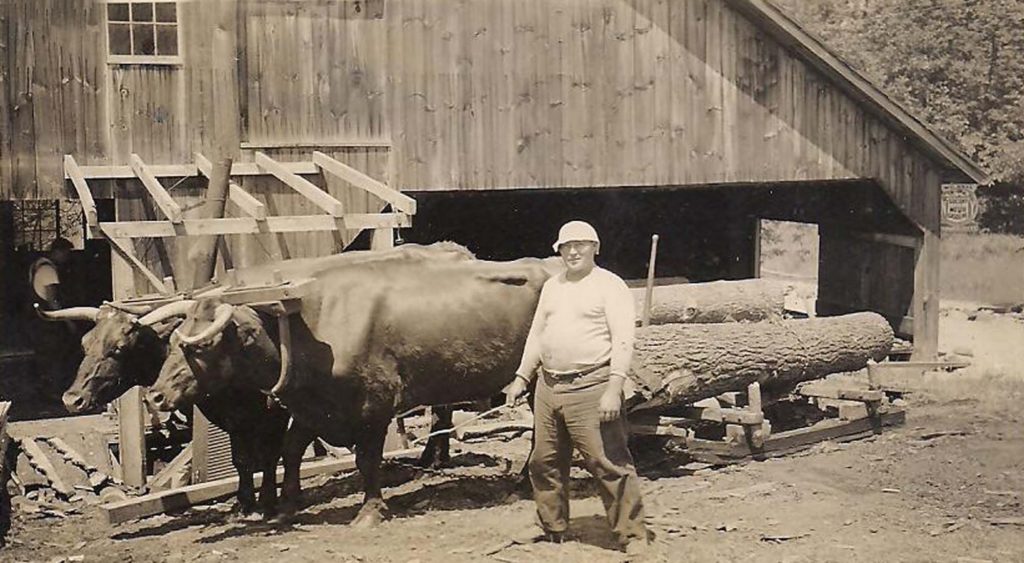West Woodstock’s Chamberlin Mill is a rare example of a water-powered circular saw mill converted to gasoline power. A two-story post and beam structure with expansive loft, the building is supported on a high, dry-laid, field stone foundation that incorporates the penstock and turbine. This sturdy structure still houses many of the historic cast iron gears and flat belt pulleys that transferred the power of water via a turbine to the circular saw.
The mill is situated along the Still River, adjacent to Old Turnpike Road, a quiet country road that was once the Boston-Hartford Central Pike. Two connecting dammed ponds immediately north of the road provided water to power the mill’s turbine, the roadbed serving as a lower dam.
The Chamberlin Mill’s Place in History

Section of John S. Lester’s 1883 Map of Woodstock, CT. Mill is located near Woodstock’s western border, midway from top to bottom on this map. Lyman Sessions homestead, connected with the Mill, is indicated on the map.
The existing building dates to the turn of the 20th century, the latest in a succession of mill structures that have occupied the Still River site since the 18th century (when Manasseh Hosmer was granted a deed for a grist mill and saw mill). For over two centuries, beginning in the early 1800s, generations of the Sessions-Stone-Chamberlin-Tayler family owned this land, operating small-scale grist and sawmills well into the 1800s and a sawmill through the 1960s.
Historically, activities at the mill followed the seasons. The owners drew logs from surrounding woods in the winter, ran the mill through the spring when water was high, and in summer, planted crops and drew down the water level of Lower Chamberlin Pond to grow hay. Lyman Sessions, owner of the site for much of the 19th century, also ran a store and was a leader in the once-thriving Woodstock shoe industry. Other family members supplemented farming and sawmill work by building local barns and houses.
Since the sawmill continued in use through World War II, its parts were not scrapped, allowing it, unlike many of its counterparts, to remain intact. The existing building contained an 1873 Lane # 1 circular saw, as well as an early Muzzy shingle saw, a bolt saw (for cutting shingle bolts), a planer, and perhaps other related machinery. The circular saw and bolt saw survive, as do a collection of shingle bolts and shingles, an old logging sled, and other artifacts. An original large mill stone serves as a reminder of the site’s grist mill history.
Surviving Natural Disasters
The Great Flood of 1936 permanently altered how the mill functioned. Although the building itself survived, the flood surged through the mill, damaging its penstock and lower dam and ending its ability to use water power.

1936 photo showing The Great Flood overtaking the lower dam of Chamberlin Mill, in background center right.
Unlike the Great Flood, which presented a potentially terminal disaster for the mill, the 1938 hurricane provided a bounty of felled trees and gave the mill an opportunity for renewed life. In 1939, the Chamberlins constructed a shed to house a new power source, a 1928 Studebaker President engine. For a while oxen continued to draw the logging sled to the mill, but eventually they too were replaced by a homemade motorized skidder.
After the saw mill ceased operation in the 1960s, the building remained dormant for four decades, until The Nature Conservancy purchased it from the Chamberlin family as part of a 98-acre Still River Preserve. Discussions with local history organizations led to the establishment of Chamberlin Mill, Inc., a non-profit organization, which acquired the mill and a small footprint of land in 2014. This group is revitalizing the site as a historical and educational asset.
With the support of various grants and a community of Friends and volunteers, Chamberlin Mill, Inc. has been actively restoring the structure, bringing the 1928 Studebaker engine back to life, and rebuilding the 1873 saw.









